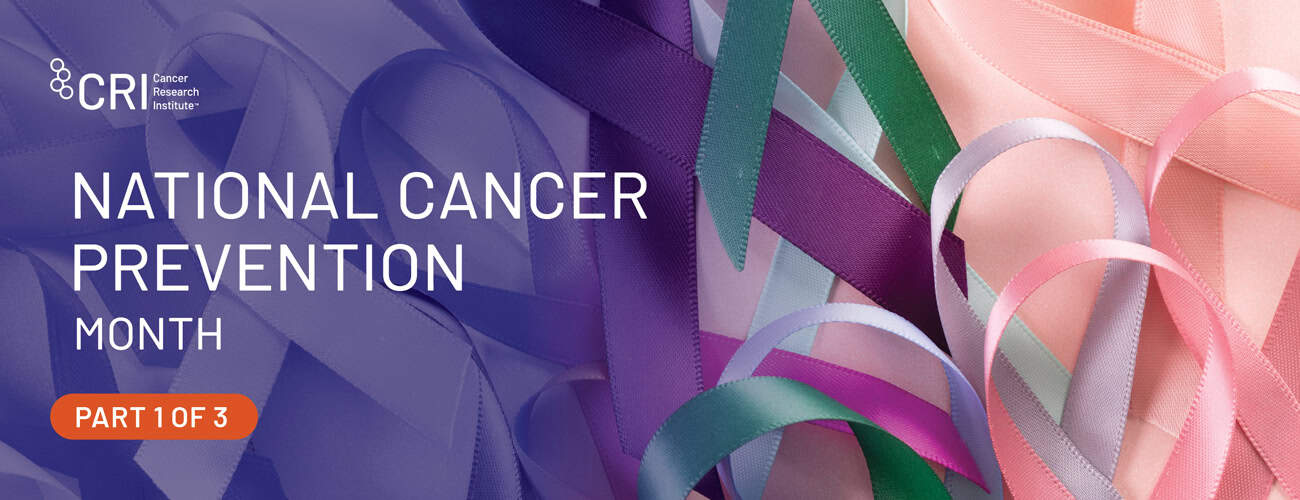February is National Cancer Prevention Awareness Month, a time to reflect on the steps we can take to reduce our risk of cancer. While some factors – like genetics- are beyond our control, the latest data published by the American Cancer Society shows that nearly 40% of cancer cases and 44% of cancer-related deaths are linked to preventable lifestyle choices. By making informed decisions about what we eat, drink, and expose ourselves to, we can significantly lower our cancer risk.
Smoking: The Leading Culprit
This one is a no-brainer. We all know about the harmful effects of smoking and consuming tobacco products – the adverse health effects can range from asthma and COPD to lung cancer. Smoking remains the #1 most significant preventable cause of cancer, accounting for about 19.3% of cancer cases and 28.5% of cancer deaths[1].
What might be surprising to some people is to learn that smoking doesn’t just increase your risk for lung cancer, it is also linked to an alarming array of 20 different cancers including esophageal-, colorectal-, liver-, pancreatic-, and ovarian cancer.
The science is clear: secondhand smoke exposure can lead to detrimental health outcomes, including cancer. CRI Clinical Innovator Thomas Marron, MD, PhD (Icahn School of Medicine at Mount Sinai) specializes in treating lung cancer patients. He says, “quitting smoking is not only important for the smoker, but also for their family members because the ambient smoke can cause cancers related to second-hand smoke.”
Prevention Tip:
Quitting smoking at any age significantly reduces cancer risk. It’s not about how many years you’ve already smoked; it’s about how many future years of non-smoking can you give yourself. Support is available through nicotine replacement therapies. The National Texting Portal is a collaborative system by Center for Disease Control and Prevention (CDC) and National Institutes of Health (NIH) that provides free, evidence-based text messaging services to help U.S. smokers quit by offering support, advice, and tips. Interested individuals can avail themselves of the service by texting QUITNOW to 333888.
Alcohol: A Hidden Danger
Alcohol, in any amount, is detrimental to our health. Alcohol consumption contributes to 5.4% of cancer cases. It increases the risk of cancers in the oral cavity, pharynx, esophagus, colorectum, liver, larynx, and breast. CRI Clinical Innovator Marina Baretti, MD (Johns Hopkins University School of Medicine), recently highlighted the importance of controlling alcohol intake. “The recommendation is really to either stay away or (have) no more than two drinks per day for a man (and) no more than one drink per day for a woman,” she advised.
Prevention Tip:
Limit alcohol intake or consider abstaining completely. If you drink, try to follow CDC guidelines of no more than one drink per day for women and two for men. If social pressure is one of the reasons you find yourself drinking more than you’d like, consider finding alternative ways to meet with friends instead of over drinks – take a walk, go for a hike, play pickleball!
Diet: You Are What You Eat
Our dietary habits can make a real difference towards our cancer risk. Consumption of red meat (beef, pork, veal, lamb, etc) and processed meats (smoked and cured meats, cold cuts, sausages, etc) have been shown to increase a person’s risk for colorectal cancer. In addition, excess body weight is also a significant and preventable risk factor for cancer. Research has shown that high BMI is associated with an increased risk of developing 13 to 18 types of cancer. This is because high BMI is often correlated with hormonal changes, chronic inflammation, and decreased efficiency of the immune system – all of which are risk factors for cancer.
Prevention Tip:
The World Cancer Research Fund International recommends limiting weekly consumption of red meat to 3 portions or 12-18 Oz [2]. Aim for a balanced diet rich in fruits, vegetables, whole grains, and lean proteins. Maintain a healthy weight through proper nutrition and regular physical activity. The US Department of Health and Human Services recommends 30-45 mins of moderate aerobic exercise daily, to reduce the risk of chronic diseases including cancer. These activities are not just good for your heart, they also help prevent cancer!
Ultra Violet Exposure: Protecting Your Skin
Ultra Violet (UV) radiation from the sun and tanning beds contributes to 4.6% of cancer cases. In fact, it’s the primary cause of melanoma, the deadliest form of skin cancer.Of the over five million annual global cases of skin cancer, a whopping 90% of diagnoses are a direct result of direct exposure to UV rays. Even though cancer caused by UV radiation is more common in people with lighter skin tones, everyone is susceptible.
Prevention Tip:
The United States Food and Drug Administration (FDA) recommends using a broad-spectrum sunscreen with SPF 15 or higher[3]. Avoiding tanning beds and seek shade during peak sunlight hours will also reduce your exposure to UV. Also – don’t forget those sunglasses! Protecting your eyes from UV rays is just as important and can help prevent eye-related cancers and other diseases.
Infections: An Often-Overlooked Factor
It may come as a surprise, but infections caused by viruses and certain bacteria play a significant role in cancer development. In fact, they account for approximately 13% of cancer cases globally. They can lead to cancer through mechanisms like chronic inflammation, immune suppression, and genetic alterations in cells. Human papilloma virus (HPV) infection is the main cause of cervical cancer and can be prevented through vaccination. Hepatitis B and C are linked to liver cancer and can also be prevented by vaccine. More recently, studies have shown that chronic gastrointestinal infection caused by the bacteria H. pylori can also lead to stomach cancer.
Prevention Tip:
Getting vaccinated against virus like HPV, hepatitis B is a sure way to reduce the risk of infection-related cancers. The Center for Disease Control and Prevention (CDC) recommends HPV vaccine for children 11 or 12 years old, and CDC recommends hepatitis B vaccine for all age groups to protect against these viral infections. CDC also recommends people with an active gastric or duodenal ulcer, or a documented history of ulcers should be tested for H. pylori. Screening tests like urea breath tests, fecal antigen testing, or colonoscopy-assisted polyp biopsies can also help monitor the cancer risks.
Cancer prevention starts with the choices we make every day. While not all risks are within our control, many are—and small, mindful changes can add up to a lifetime of benefits. Whether it’s quitting smoking, moderating alcohol intake, adopting a healthier diet, protecting yourself from UV exposure, or staying up to date with vaccinations, every step you take moves you toward a healthier, cancer-free future. This National Cancer Prevention Awareness Month, empower yourself with knowledge, make proactive choices, and inspire others to do the same. Your future self will thank you.
[1] Proportion and number of cancer cases and deaths attributable to potentially modifiable risk factors in the United States, 2019 – Islami – 2024 – CA: A Cancer Journal for Clinicians – Wiley Online Library
[2] Limit consumption of red and processed meat | Recommendation evidence | World Cancer Research Fund
[3] Sunscreen: How to Help Protect Your Skin from the Sun | FDA

